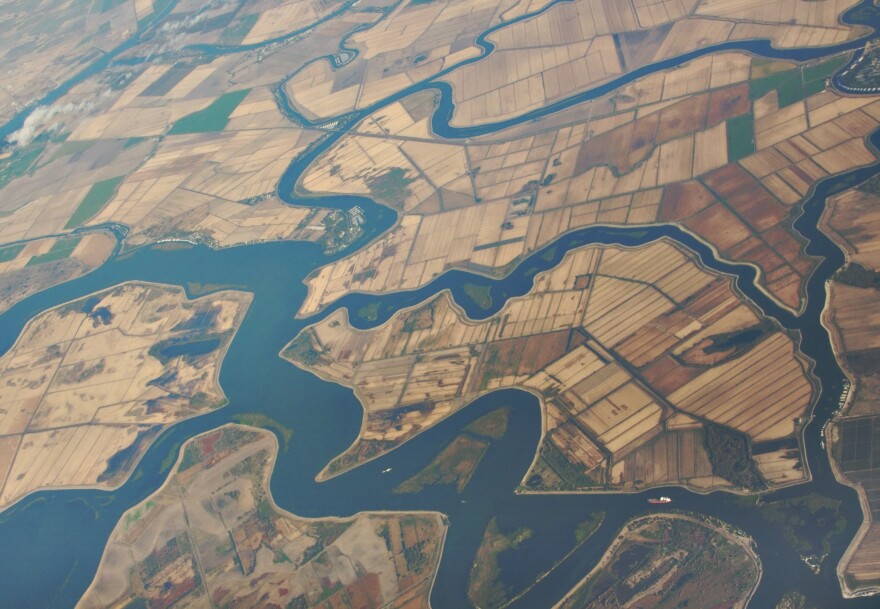With our free press under threat and federal funding for public media gone, your support matters more than ever. Help keep the LAist newsroom strong, become a monthly member or increase your support today.
8 things Southern Californians should know about the controversial Delta tunnels project

The most powerful water agency in Southern California stepped up its lobbying this week in support of a project that would change how we get a third of our drinking water.
It’s called the California WaterFix. The project, formerly known as the Bay Delta Conservation Plan, would build two massive tunnels beneath the Sacramento–San Joaquin River Delta, replacing the northern portion of the State Water Project, a 600-mile-long system of tunnels, reservoirs and canals that moves water from Northern to Southern California.
The tunnel proposal has been in the works for years, and similar ideas have been kicked around for decades.
Here’s what you need to know.
What is the California WaterFix, and what would it do?
Fresh water flows from the Sierra Nevada into the Sacramento and San Joaquin rivers and mixes in with saltwater in a giant estuary called “the Delta” just east of San Francisco Bay. Currently, two gigantic pumps suck fresh water from the southern part of the Delta near Tracy into the State Water Project, where it begins its journey to Central Valley farms and cities in Southern California.
The WaterFix would change the point at which fresh water enters the State Water Project. It would build two 35-mile long tunnels from the beginning of the State Water Project near Tracy to the bank of the Sacramento River between Clarksburg and Courtland. The tunnels would be 40 feet wide and buried 150 feet underground.
What’s the problem it’s trying to fix?
There are two problems: human and environmental.
Decades of pumping fresh water out of the Delta have taken a toll on the ecosystem. Formerly common fish species like Delta smelt, Chinook salmon and sturgeon are now rare, even bordering on extinction.
In order to save fish populations, state officials have at times cut back on the amount of water they pump out of the Delta. The drought has exacerbated the problem by reducing the amount of water flowing into the Delta in the first place.
The result is that in recent years, the people who depend on State Water Project – almost all of Southern California and farmers in the Central Valley – haven’t been getting the water they’ve been promised. This year, they got 60 percent, but in 2014 it was just 5 percent.
Finally, there’s a risk than an earthquake would destroy the levees in the Delta, inundating the pumps with seawater. Climate change and sea level rise could slowly do the same thing.
Why should Southern Californians care about this?
A third of the water that comes out of our faucets in Southern California is sucked through the pumps in the Delta. In some areas, like those served by the Las Virgenes Water District, imported water makes up 100% of the total supply. The Delta is one of the most vulnerable parts of arguably the most important piece of water infrastructure in the state.
How much will the California WaterFix cost, and who will pay for it?
The official estimate is $15 billion.
Everyone who relies on water from the State Water Project will pay for the project. That includes farmers throughout the Central Valley and residents of Southern California.
Costs are likely to be calculated based upon how much water each water agency uses, according to Roger Patterson, assistant general manager of Metropolitan Water District, a water wholesaler that supplies 19 million people from San Diego to Oxnard. For example, MWD takes approximately 30% of the State Water Project's supply, so it would pay 30% of the cost of the tunnels.
How long would it take to build?
Ten to fifteen years. But the project is still at least a year away from beginning construction, according to project spokesman Erin Mellon. The State Water Resources Conservation Board just began hearings on the project, which will continue through next winter, and it still needs several key environmental permits.
Who is supporting it and why?
Gov. Jerry Brown and urban water agencies in Southern California, especially MWD, are the leading proponents of the project. They say the project is necessary to maintain the reliability of water supplies to Central and Southern California, which are currently threatened by drought, rising sea level, earthquakes and pumping reductions due to environmental problems in the Delta.
“Our current water system wasn’t designed for these types of hydrological and environmental conditions,” said Mark Cowin, the head of the California Department of Water Resources.
Supporters also say that pumping water from the Sacramento River will be less damaging to the Delta ecosystem than the current pumps, which create unnatural flows in the Delta and suck in fish.
Who is against it and why?
Many people living around the Delta oppose the plan. They say the tunnels will degrade local water quality, affecting the many farms in and adjacent to the Delta.
Northern Californians are also suspicious that the tunnels are just another Southern California water grab. “You turn your back on a giant estuary for a minute and look what happens,” noted Curbed San Francisco. “The rest of California is stealing our water.”
Finally, environmentalists say the tunnels will actually worsen environmental problems in the Delta, leading to the extinction of several native fish.
Who gets to decide?
Currently state agencies hold the power to permit or deny the project, although water agencies have to decide whether they are willing to pay for it.
But that could change if Proposition 53 passes this November. Prop 53 would require all projects funded by more than $2 billion in state bonds to be put before voters. If it passes, the California WaterFix may have to go on the ballot (as would the California High-Speed Rail Project).







